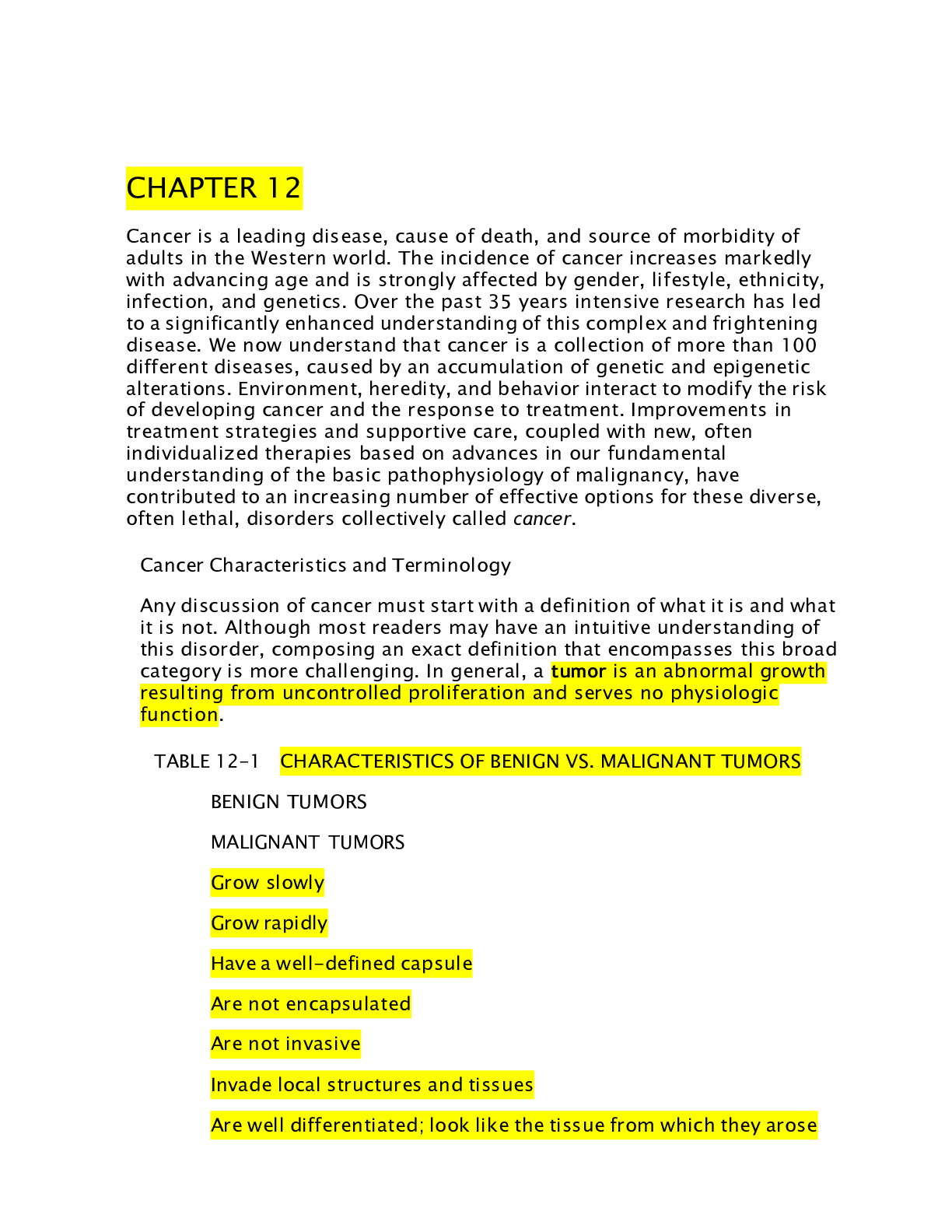*NURSING > STUDY GUIDE > CHAPTER 12 nursing 3129 Cancer Characteristics and Terminology (All)
CHAPTER 12 nursing 3129 Cancer Characteristics and Terminology
Document Content and Description Below
CHAPTER 12 Cancer is a leading disease, cause of death, and source of morbidity of adults in the Western world. The incidence of cancer increases markedly with advancing age and is strongly affected ... by gender, lifestyle, ethnicity, infection, and genetics. Over the past 35 years intensive research has led to a significantly enhanced understanding of this complex and frightening disease. We now understand that cancer is a collection of more than 100 different diseases, caused by an accumulation of genetic and epigenetic alterations. Environment, heredity, and behavior interact to modify the risk of developing cancer and the response to treatment. Improvements in treatment strategies and supportive care, coupled with new, often individualized therapies based on advances in our fundamental understanding of the basic pathophysiology of malignancy, have contributed to an increasing number of effective options for these diverse, often lethal, disorders collectively called cancer. Cancer Characteristics and Terminology Any discussion of cancer must start with a definition of what it is and what it is not. Although most readers may have an intuitive understanding of this disorder, composing an exact definition that encompasses this broad category is more challenging. In general, a tumor is an abnormal growth resulting from uncontrolled proliferation and serves no physiologic function. TABLE 12-1 CHARACTERISTICS OF BENIGN VS. MALIGNANT TUMORS BENIGN TUMORS MALIGNANT TUMORS Grow slowly Grow rapidly Have a well-defined capsule Are not encapsulated Are not invasive Invade local structures and tissues Are well differentiated; look like the tissue from which they arose Are poorly differentiated; may not be able to determine tissue of origin Have a low mitotic index; dividing cells are rare High mitotic index; many dividing cells Do not metastasize Can spread distantly, often through blood vessels and lymphatics The term cancer derives from the Greek word for crab, karkinoma, which the physician Hippocrates used to describe the appendage-like projections extending from tumors. The word tumor originally referred to any swelling that was caused by inflammation, but is now generally reserved for describing a new growth, or neoplasm. Not all tumors or neoplasms, however, are cancer. The term cancer refers to a malignant tumor and is not used to refer to benign growths, such as lipomas or hypertrophy of an organ. Yet it is important to recognize that benign neoplasms also can be life threatening if they enlarge in critical locations. For example, a benign meningioma at the base of the skull may cause symptoms by compressing adjacent normal brain tissue. The definitions of benign vs. malignant are presented in the following text and in Table 12-1. Tumor Classification and Nomenclature Proper identification of a cancer is important for many reasons. Different lesions will have different causes, different rates and patterns of progression, and different responses to treatment. Cancer classification starts with knowing the site of origin and microscopic appearance of the lesion, but can extend to a detailed description of critical genetic changes in the cancer. Benign tumors, which are not referred to as cancers, are usually encapsulated and well differentiated. They retain some normal tissue structure and do not invade the capsules surrounding them or spread to regional lymph nodes or distant locations. Benign tumors are generally named according to the tissues from which they arise, and include the suffix “-oma.” For example, a benign tumor of the smooth muscle of the uterus is a leiomyoma, and a benign tumor of fat cells is a lipoma. Some tumors initially described as benign can progress to cancer and then are referred to as malignant tumors. These tumors are distinguished from benign tumors by their more rapid growth rates and specific microscopic alterations, including loss of differentiation and absence of normal tissue organization. One of the hallmarks of cancer cells, as seen under the microscope, is anaplasia, the loss of cellular differentiation, irregularities of the size and shape of the nucleus, and the loss of normal tissue structure. Malignant tumors may present with different degrees of encapsulation; some lack a capsule, and even if a capsule is apparent, its integrity has been compromised so that tumor cells can grow to invade nearby blood vessels, lymphatics, and surrounding structures. The most important and most deadly characteristic of malignant tumors is their ability to spread far beyond the tissue of origin, a process known as metastasis (Figures 12-1 and 12- 2; see Table 12-1). ..........................................................................................continued............................................................................... [Show More]
Last updated: 2 years ago
Preview 1 out of 95 pages

Buy this document to get the full access instantly
Instant Download Access after purchase
Buy NowInstant download
We Accept:

Reviews( 0 )
$13.00
Can't find what you want? Try our AI powered Search
Document information
Connected school, study & course
About the document
Uploaded On
Jul 17, 2021
Number of pages
95
Written in
Additional information
This document has been written for:
Uploaded
Jul 17, 2021
Downloads
0
Views
100






.png)

.png)



